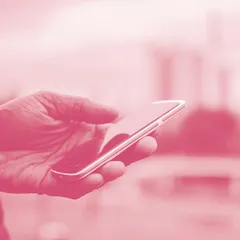Smartphones Are a New Tax on the Poor智能手机是新型“穷人税”
作者: 朱莉娅·泰科纳 郑玢

Damon, who works full-time at an upscale hotel and part-time at a burger joint in Washington, DC, gets his weekly schedules through texts from his managers, often with last-minute requests to come in to cover for missing coworkers. To make sure he can receive these messages, Damon juggles1 two basically broken low-end smartphones, one with a shattered screen and another that turns on and off unpredictably when he tries to use it. “I’m waiting on my next check so I can get another phone,” he told me. Meanwhile, he’s using stagnant wages to purchase a phone that’s functionally a workplace requirement, all just to keep the jobs he has now.
戴蒙在华盛顿特区的一家高档酒店全职工作,也在一家汉堡店做兼职。他通过经理发来的短信获知每周的工作安排,而短信内容经常是临时要求他来代失联同事的班。为了确保能收到信息,戴蒙得费劲地摆弄两部基本坏掉的低端智能手机,一部屏幕碎了,另一部用起来,说不准什么时候就自动开关机。他告诉我:“我正盼着马上要发的工资,到时就能换一部手机。”同时,他打算用死活不涨的工资买一部工作必需的手机,这么做只是为了保住他现在的工作。
Science fiction author William Gibson famously said that the future is already here, it’s just not very evenly distributed. Smartphones and on-the-go internet access have made many of our working lives more efficient and flexible. But the requirement for constant connectivity isn’t only a fact of white-collar work—it has spread to workers up and down the income ladder. And while the requirement has spread, the resources that workers need to maintain it are not evenly distributed. Today, more than a quarter of low-income Americans depend solely on their phones for internet access. Amid historic levels of income inequality, phones and data plans have become an increasingly costly burden on those who have the least to spare.
科幻小说家威廉·吉布森有句名言:未来早已到来,只是尚未均匀分布。智能手机和随时随地接入的互联网使我们在大部分的工作时间里更加高效和灵活。但是,保持联网的要求不仅针对白领,而是波及各个收入阶层,无论高低。虽然这种要求已得到普及,但劳动者为长期符合这种要求所需的资源并不是平均分配的。今天,超过四分之一的低收入美国人只能依赖手机上网。在收入不平等程度达到历史最高的情况下,手机和流量套餐对于兜里所剩无几的人来说,已成为越来越沉重的负担。
Through interviews with precarious workers across the country, I’ve found that connectivity to the internet is increasingly required to manage many different types of jobs in parts of low-wage labor markets far beyond “gig economy2” apps like Uber and Postmates. In ignoring these hidden kinds of connectivity, we don’t see their mounting costs, and the consequences for marginalized people. The requirement to maintain their connectivity constitutes a kind of new tax on low-wage workers. And well-meaning interventions focused on closing the digital divide3 haven’t addressed the powerful interests at work keeping it open.
通过采访全国各地收入不稳定的劳动者,我发现在部分低薪劳动力市场,完成许多不同类型的工作对联网的要求越来越高,而且远不止使用优步和Postmates 等“零工经济”应用程序。由于忽视了这类隐藏的联网方式,我们没有看到它们不断增加的成本,以及给边缘人群带来的影响。保持联网的要求构成了针对低薪劳动人群的新税种。然而,致力于缩小数字鸿沟的善意干预措施,并没有触及维护数字鸿沟的强大利益集团。
The high costs of connectivity represent an increasingly large slice of household incomes for low-wage workers. Even though maintaining these connections has become necessary for many low-wage workers, their incomes have not kept pace. According to 2020 numbers from the US Bureau of Labor Statistics, those in the lowest 20 percent of income earners spent $150 more a year on their cell phones than they did in 2016. The cost of connectivity represents more than half of what these households spent on electricity, and nearly 80 percent of what they paid for gas. As a proportion of household income, the lowest earners spent four times more on phones than high earners. With inflation looming, these issues are likely to get worse before they get better.
高昂的联网费用在低薪劳动者家庭收入中的占比与日俱增。尽管保持联网对许多低薪劳动者来说是必要的,但他们的收入却没有跟上。美国劳工统计局2020年的数据显示,收入最低的那20% 的人,每年花在手机上的钱比2016年多了150美元。联网费用相当于这类家庭一半以上的电费支出,以及近八成的天然气费用。从在家庭收入中的占比来看,收入最低人群花在手机上的费用是高收入人群的4 倍。通货膨胀迫在眉睫,这些问题只会恶化,而不会好转。
While these gaps in spending might be predictable, they’re not inevitable. As connectivity has become increasingly mandatory for low-wage workers, phone companies catering to this market segment have profited by engaging in predatory inclusion. As Louise Seamster and Raphaël Charron-Chénier explain, these forms of inclusion offer access to goods that marginalized groups had previously been excluded from but on terms that ultimately undercut the benefits of access. Consumers that previously couldn’t afford the high up-front costs of buying a smartphone, or whose unpredictable incomes meant annual contracts were out of reach, can now get access to a smartphone and data plan with less-than-perfect credit, but under exploitative conditions that make connectivity more expensive. Black consumers are particularly targeted for these forms of inclusion, as systemic discrimination in labor, housing, and financial services have created gaps in credit scores that make prepaid and phone rentals nearly the only option.
支出的差距或许可以预见,但并非不可避免。随着联网对低薪劳动者来说越来越具强制性,服务于这一细分市场的通信公司通过“掠夺性包容”从中牟利。正如路易丝·西姆斯特和拉斐尔·查伦-谢尼埃所解释的,这些形式的包容使边缘群体得以获取以前不可及的商品,但这种包容是有代价的,可及性的福利最终会被削弱。有的消费者以前无法负担购买智能手机的高额预付费用,还有的因收入不稳定而无法购买按年缴费的合约机,他们现在可以凭借不尽如人意的信用评分买到智能手机和流量套餐,但剥削性条款使联网费用更加昂贵。掠夺性包容格外针对黑人消费者,因为他们在工作、住房和金融服务方面受到的系统性歧视造成了信用评分的差距,预付费和租赁手机几乎成为他们唯一的选择。
In 2019, New York City sued T-Mobile for a host of violations of consumer rights, including enrolling people into third-party financing through companies like SmartPay, which split payments up over time through rental agreements, but ultimately add hundreds of dollars onto advertised prices, without full explanations of the terms—eventually ruining people’s credit. Phone leasing programs and their opaque terms of service have also resulted in other legal actions (for example, Sprint is facing a class action suit over similar issues). These actions have taken place against a backdrop of consolidation in the mobile phone market, as Sprint and T-Mobile, two companies that had previously competed for low-income consumers, have merged, raising concerns about rising costs in the future.